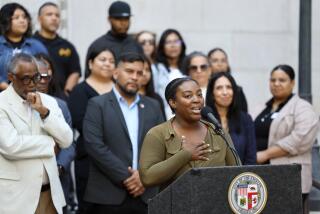Touting Communities’ Hope
- Share via
Ten years after riots scarred South Los Angeles and gave birth to Operation Hope, the founder of the nonprofit organization loaded dozens of bankers and scores of community leaders onto buses Wednesday to show off neighborhood progress.
Although plenty remains to be done, group founder John Bryant pointed to progress throughout the area as five buses rumbled through the Crenshaw district, the thriving Latino commercial corridor of Huntington Park, Inglewood’s small-business district and the high-priced homes of Baldwin Hills.
Many of South-Central’s grimmest corridors were not part of the tour. But newly built housing developments and reconstructed shopping centers in more broadly defined South Los Angeles, along with neatly landscaped residential streets, impressed some first-time visitors.
“This will definitely give the bank more confidence in this area,” said Alan Thian, chairman and chief executive of Rosemead-based First Continental Bank. “My impression has always been that South-Central is pretty run-down.”
Thian said his bank--with $270 million in assets--has financed some mom-and-pop laundermats in South Los Angeles. But Wednesday he saw that larger-scale commercial development has taken place and more is possible.
Bryant formed Operation Hope as a 26-year-old businessman with a passionate yet vaguely formed notion to turn things around. His first bus tour netted eight bankers. But in the decade, the organization--and the tours--have grown.
Bryant has become a key contact for banks large and small throughout the region that have increased their lending activity in South Los Angeles while pouring millions into Operation Hope.
And the bankers have found a guide to potential lending opportunities in neighborhoods they long feared, and a vehicle to meet mandatory federal Community Reinvestment Act requirements.
“We wouldn’t give them money if we weren’t getting something out of it,” said Gary S. Dunn, vice president of Fremont Investment & Loan, an Anaheim Hills-based institution that joined Bryant’s board after the riots and has increased its lending in low-income pockets of Los Angeles and Huntington Park as a result.
Bryant concedes that he puts an aggressively positive spin on South Los Angeles. As he handed out copies of his newly released book on financial literacy, he promised participants they would see no graffiti or drug dealers in his South-Central. But as buses cruised down Vermont Avenue toward Florence, they passed more than six police cars guarding a corner blocked by yellow crime scene tape.
Marva Smith Battle-Bey, executive director of the Vermont Slauson Economic Development Corp., was slightly more realistic as the bus she guided edged west on Slauson Avenue. One strip mall that her organization purchased in 1986 tanked, and the group sold it a few years later, she said. Rioters torched it in 1992 and the lot still sits empty.
“Maybe someone will come along and rediscover that property,” she said hopefully.
To Bryant, however, hope is a tool in itself, and showing bankers the positive change has helped shift their mind-set over the last decade.
More to Read
Sign up for Essential California
The most important California stories and recommendations in your inbox every morning.
You may occasionally receive promotional content from the Los Angeles Times.











